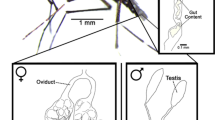Abstract
Many studies have attempted to assess the relative effects of different vectors of a disease on animal populations. To this end, three measures have been proposed: Vectorial efficiency, Vectorial capacity and recently Vectorial effectiveness (or Vectorial impact). In this study we relate these measures to derive some of their properties emphasising in the vectorial impact for its importance in both, population performance of parasites and the proportion of the prevalence of one parasite due to a given vector. We applied the quantitative expressions advanced in this study to a simple Chilean example with one parasite (Trypanosoma cruzi), two vectors (Triatoma infestans and Mepraia spinolai) and one animal population (humans: Chagas's disease).
Similar content being viewed by others
REFERENCES
Anderson, R.M. 1993. Epidemiology. In Modern Parasitology. Cox, F. E. G. Ed. Blackwell Scientific Publications: 75–117.
Anderson, R. M., and R. M. May. 1979. Population biology of infectious diseases: Part I. Nature 280: 361–367.
Apt, W. B., and H. Reyes. 1990. Algunos aspectos de la enfermedad de Chagas en Latinoamérica. Parasitología al Día 14: 23–40.
Bailey, N. T. J. 1975. The mathematical theory of infectious diseases and its applications. Oxford University Press. N. Y. U.S.A.
Burkot, T. R., P. M. Graves, R. A. Paru, R. A. Wirtz, and P. H. Hywood. 1988. Human malaria transmission studies in the Anopheles punctulatus complex in New Ginea: Sporozoite rates, inoculation rates, and sporozoite densities. American Journal of Tropical Medicine and Hygiene 39: 135–144.
Bustamante, R. O., and M. L. Canals. 1995. Dispersal quality in plants: how to measure efficiency and effectiveness of a seed disperser. OIKOS 73(1): 133–136.
Canals, M., P. E. Cattan, and M. H. Ehrenfeld. 1993. Algunas estimaciones numéricas de la importancia epidemiológica de los vectores de la enfermedad de Chagas en Chile. Parasitologia al Día 17: 79–86.
Canals, M., R. Solís, C. Tapia, M. Ehrenfeld, and P. E. Cattan. 1998a. Comparison of some behavioural and physiological parameters of the feeding of Triatoma infestans KLUG, 1834 and Mepraia spinolai PORTER, 1934; vectors of the Chagas's disease in Chile. Memorias do Instituto Oswaldo Cruz (submitted).
Canals, M., L. Cruzat, and P.E. Cattan. 1998b. Alimentary profile of Mepraia spinolai Porter, 1934 (Hemiptera, Reduviidae), vector of Chagas's disease. Bulletin of Entomological Research (submitted).
Dobson, A. P., and P. J. Hudson. 1986. Parasites, disease and the structure of ecological communities. Trends in Ecology and Evolution 1: 11–15.
Ewald, P. W. 1995. The evolution of virulence: a unifying link between parasitology and ecology. Journal of Parasitology 81(5):659–669.
Garret-Jones, C. 1964a. Prognosis for interruption of malaria transmission trogh assesment of the mosquito's vectorial capacity. Nature 204: 1173–1175.
Garret-Jones, C. 1964b. The human blood index of malaria vectors in relation to epidemiological assesment. WHO Bulletin 30: 241–261.
Garret-Jones, C., and G. R. Shridawi. 1969. Malaria vectorial capacity of a population of Anopheles gambiae. WHO Bulletin 40: 531–545.
Garret-Jones, C., P. F. Boreham, and C. P. Pant. 1980. Feeding habit of Anophelines in 1971–1978, with reference to the human blood index: a review. Bulletin of Entomological Research 70: 165–185.
Gulland F.M.D. 1995. The impact of infectious diseases on wild animal populations-a review. In Ecology of infectious diseases in natural populations. Grenfell B.T. and Dobson A.P. Eds. Cambridge University Press: 20–51.
Holmes, J. C. 1982. Impact of infectious diseases agents on the population growth and geographical distribution of animals. In Population biology of infectious diseases. Anderson, R. M., and R. M. May Eds. Dahlem Konferenzen. Berlin, Heidelberg, New York. Springer-Verlag: 37–51.
Lehane, M. J. 1991. Biology of blood-sucking insects. Harper Collins Academic. London. UK.
Loye, J. E., and S. P. Carroll, 1995. Birds, bugs and blood: avian parasitism and conservation. Trends in Ecology and Evolution 10(6): 232–235.
May, R. M., and R. M. Anderson. 1979. Population biology of infectious diseases: Part II. Nature 280: 455–461.
Mc Donald, G., C. Cuellar, and C. Foll. 1968. The dynamics of malaria. WHO Bulletin 38: 743–755.
Mendis, C. H., A. C. Camage-Mendis, P. R. Herath, A. P. De Zoysa, T. A. Abhayawardana, R. C. Carter, and K. L. Mendis. 1990. Characteristics of malaria transmission in Kataragana, Sri Lanka: A focus for immunoepidemiological studies. American Journal of Tropical Medicine and Hygiene 42: 283–308.
Mendis, C. H., P. R. Herath, J. Rajakarime, S. D. Weerasinghe, A. C. Camage-Mendis, K. L. Mendis, and A. P. De Zoysa. 1992. Method to estimate relative transmission efficiencies of Anopheles species in human malaria transmission. Journal of Medical Entomology 29: 188–197.
Molineaux, L. D., D. A. Muis, H. C. Spencer, and W. H. Werndorffer. 1988. The epidemiology of malaria and its measurement. In Principles and Practices in malariology. W. H. Werndorffer and Mc Gregor Eds. Churchill Livingstone, England.
Molyneaux, D. H., and D. Jefferies. 1986. Feeding behavior of pathogen-infected vectors. Parasitology 92: 721–736.
Myers, J. H., and L. E. Rothman. 1995. Virulence and transmission of infectious diseases in humans and insects: evolutionary and demographic patterns. Trends in Ecology and Evolution 10(5): 194–198.
Rabinovich, J., and O. Rossel. 1978. Matemathicak models and ecology of Chagas's disease. PAHO Scientific publications 318: 359–369.
Reyes, H. 1991. Estado actual de la enfermedad de Chagas en Chile. Historia, distribución, ecología y demografía. Taller sobre la erradicación o control de la enfermedad de Chagas en Chile. Sociedad chilena de Parasitología.
Schenone, H., H. Christensen, A. De Vasquez, C. Gonzalez, E. Mendez, A. Rojas, and F. Villaroel. 1985. Fuentes de alimentación de Triatomas domésticos y su implicancia epidemiológica en relación a la enfermedad de Chagas en áreas rurales de siete regiones de Chile. Boletin chileno de Parasitología 40: 34–38.
Rights and permissions
About this article
Cite this article
Canals, M., Bustamante, R.O., Ehrenfeld, M.H. et al. Assessing the Impact of Disease Vectors on Animal Populations. Acta Biotheor 46, 337–345 (1998). https://doi.org/10.1023/A:1001891017457
Issue Date:
DOI: https://doi.org/10.1023/A:1001891017457




